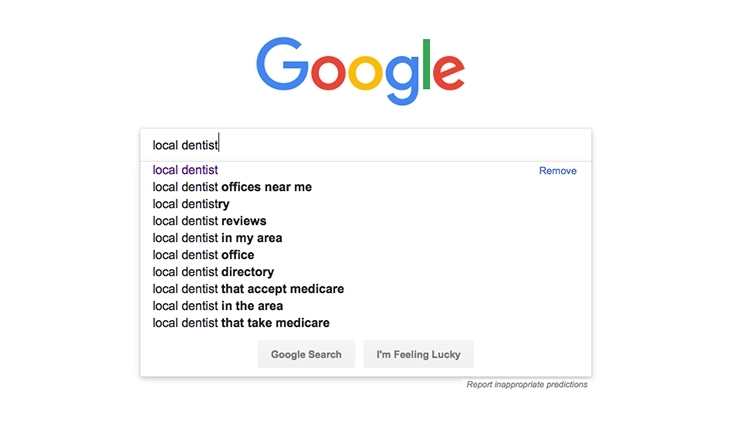
Search engine optimization (SEO) has long been a staple of digital dental marketing. Its importance has not waned, but best practices have changed. Although most Google algorithm updates are quite minor, a few change the rules of SEO. The past couple of years have seen a few such updates, the most important of which—BERT—went largely unnoticed.
The Evolution of Google Searches
For dentists and others in healthcare, the Medic update of 2018 was one of the most impactful in recent years, with many significant decreases in web traffic. The hardest hit sites were those in holistic and alternative medicine niches, as well as mainstream websites that didn’t meet Google’s EAT (expertise, authority, trustworthiness) standards.
The next update that likely caught your attention occurred in November of 2019 and focused on local queries. It uses a technology called neuralmatching, which essentially helps Google deliver more relevant results for search terms. It changed the landscape of local search by decreasing the importance of Google My Business categories and increasing the importance of information found on official company websites and elsewhere on the web.
It may surprise you to learn that the most significant update in the past five years, according to Google, is neither of these. This update, dubbed BERT, began rolling out on October 24, 2019. Google estimates that BERT will impact results for at least 10% of all searches. However, most websites haven’t seen a significant change in ranking since BERT’s launch.
What Is BERT?
BERT is an acronym, meaning Bidirectional Encoder Representations from Transformers. In simpler terms, it is a breakthrough technology that helps Google understand natural language queries, which are more common in voice search.
A couple of years ago, someone might have typed in a search for “porcelain vs composite veneers.” That type of search term is easy for Google’s algorithm to interpret. It is also easy for your marketing team to optimize and track. Today, that person might be using voice search, which lends itself to conversational queries.
A voice search user might ask, “How expensive are porcelain veneers, and are they better for my front teeth than the composite ones?” That’s enough to confuse an algorithm. Before BERT, it might have, especially since there are so many words between porcelainand composite. BERT is a machine learning technology that evaluates all words in a query, using data about speech patterns and common word usage to determine the searcher’s intent.
How BERT Is Changing SEO
If you track your dental SEO performance, the impact of BERT was probably minimal. That’s because you probably track short, commonly searched keywords. Google does not use BERT for every search. It only comes into play with long queries like the example above. Odds are that tracking results for such long and specific terms never even occurred to you, so you wouldn’t notice the difference.
How can you predict these long, chatty phrases? Often, you can’t. That is what makes SEO for BERT and voice search particularly challenging. According to Google, 15% of all searches performed are unique, meaning they’re queries that have never been asked before. That number is likely to rise along with the popularity of voice search.
Optimizing for Voice Search (and BERT)
The most common advice about BERT optimization is simply not to bother. The unpredictable nature of these queries makes it virtually impossible to choose keywords. However, BERT is essentially about improving Google’s performance in voice search. Therefore, voice search optimization essentially isBERT optimization.
Aside from length, the most notable difference between voice and text search is the format. By definition, a query is a question. Searchers are asking something, but not always in question format. Typed queries tend to be short phrases, while spoken ones are literally questions. BERT’s job is to find the answer.
To improve your results with BERT:
- Create relevant and valuable content. Don’t just add “porcelain vs composite” three times to your latest post. Focus on creating content that thoroughly and clearly explains the differences.
- Think key questions. Many SEO and keyword research tools offer suggestions of commonly asked questions about a given topic. You can supplement this research with your own personal experience. What questions do your patients ask? Build your content marketing strategy around answering these questions.
- Include FAQ pages. Patients and would-be patients appreciate the convenience of a go-to resource for easy answers to basic questions. These pages can also boost your search traffic, because frequently asked questions are frequently searched.
Conclusion
The immediate impact of BERT on your dental website may be subtle, but it is only the beginning. The future of search is beyond simple text phrases. Voice search and natural voice queries will only increase, so early adopters will have an edge on the competition.
Mr. Arulrajah, president and CEO of Ekwa Marketing, has been a leader in medical marketing for more than a decade. Ekwa provides comprehensive marketing solutions for busy dentists, with a team of more than 180 full-time professionals, providing web design, hosting, content creation, social media, reputation management, SEO, and more. If you’re looking for ways to boost your marketing results, call (855) 598-3320 for a free strategy session with him.
Related Articles
Your Dental Practice Needs a Unique Selling Proposition
Be Careful When You Duplicate Content on Your Dental Blog
Achieve Social Media Success for Your Dental Practice in Three Steps











